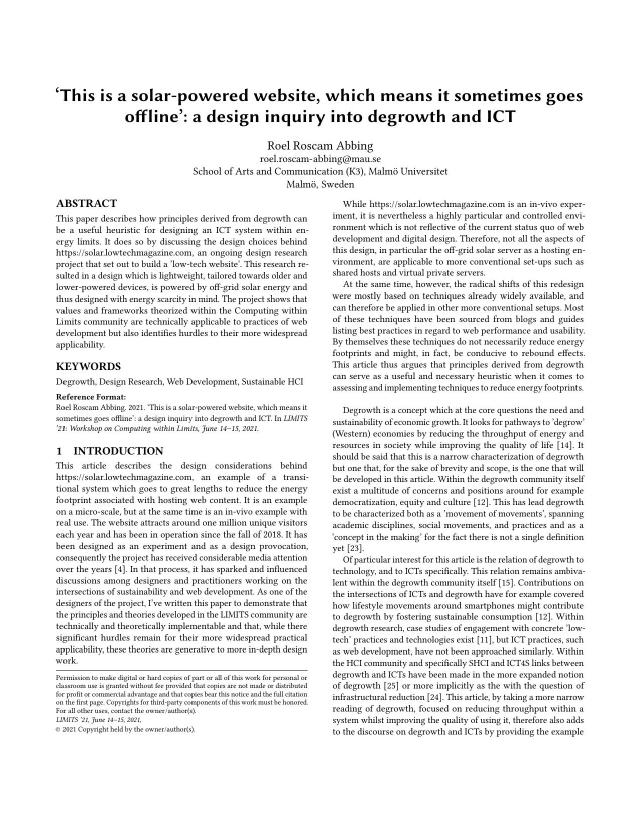Computing Within Limits 2021 Paper Presentation

On the 14th of june I presented ‘This is a solar-powered website, which means it sometimes goes offline’: a design inquiry into degrowth and ICT at Computing Within Limits. LIMITS is a yearly workshop concerning the role of computing in human societies affected by real-world limits. Planetary, ecological, social and otherwise.
tl;dr
In ‘This is a solar-powered website, which means it sometimes goes offline’ I reflect on the design process of solar.lowtechmagazine.com and specifically how principles derived from ‘degrowth’ can be a useful heuristic for guiding the design of web environments that want to limit their enegy footprint. In the paper degrowth is used in a more narrow sence where it is about reducing the throughput of energy and resources in society while improving the quality of life. In the case of a web design it would be about reducing the throughput of energy and resources in the system while improving the quality of using it. From the paper:
Concretely,this meant to limit:
- the amount of bytes transferred over the network
- the use of client-side computation and processing
- the use of server-side per-request computation
- the use of third party services
These limits are based on the fact that, as a web designer, it isnot possible to know exactly what the energy impacts are on the various parts of the system. One can, however, logically reason that the use of less computational processing leads to less use ofenergy. By extension, the speed at which a computer or networkof computers can solve a particular task, such as rendering a webpage or transporting files, can be considered a proxy for resourceusage [5]. If these tasks can be sped up by decreasing the sizes offiles or limiting the amount of computation, i.e. ’degrowing’ the computation required, these can be considered to lower the energy footprint.
The paper also outlines how some those principles connect to notions previously introduced by the LIMITS community such as infrastructural reduction1, demand flexibilization 2 and the cornucopian model of computing 1
The full article can be found on the limits pubpub https://limits.pubpub.org/pub/lecuxefc/release/1 (mirror)
-
Chris Preist, Daniel Schien, and Eli Blevis. 2016. Understanding and Mitigating the Effects of Device and Cloud Service Design Decisions on the Environmental Footprint of Digital Infrastructure. In Proceedings of the 2016 CHI Conference on Human Factors in Computing Systems (CHI ‘16). Association for Computing Machinery, New York, NY, USA, 1324–1337. DOI: https://doi.org/10.1145/2858036.2858378 ↩︎ ↩︎
-
Hilty, Lorenz (2015). Computing Efficiency, Sufficiency, and Self-sufficiency: A Model for Sustainability? In: LIMITS 2015, First Workshop on Computing within Limits, Irvine, CA, USA, 15 June 2015 - 16 June 2015, s.n.. https://www.zora.uzh.ch/id/eprint/110766/ ↩︎